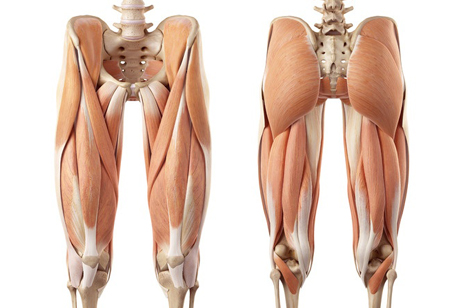
Muscles causing discomfort can be:
Muscles in the legs can often cause hip pain because they can impact the way we move, walk and even sit. For example, flat feet can result in the foot over-pronating (rolling in). This force is then transferred to the knee andup to the hip. The muscles attached at each joint are either pulled and lengthened or shortened depending on the angle and location of attachments, these imbalances can create discomfort and pain.
Gluteus medius, minimus

Imbalances creating discomfort can stem from the gluteal muscles, especially medius and minimus. These two glutealsare considered “the deltoid of the butt.” Just as the deltoid muscle lifts the arm out to the side, these lateral glutes lift the leg out to the side.” Working as a pair they act as lateral stabilizers, preventing the hips from swinging too far from side to side as you walk.Gluteus maximus, piriformis, and the lumbar paraspinal muscles are often involved as well. But because of their high lateral position, it is rarely suspected that the hip and leg pain experienced, might be radiating from tenderness or trigger points in gluteal minimus and medius. Interesting to know is that these gluteal muscles combined with the tensor facialata (TFL) and iliotibial band (ITB) are also involved with lower back pain.
Hamstrings & Quadriceps

Another common hip problem that originates in the leg is the result of overly tight hamstrings or quadriceps.Your hamstrings are located at the posterior thigh. If the hamstrings are overly tight, they pull the pelvic bone down from the attachment on the ischial tuberosity (sit bones) into a posterior tilt.
Your quadriceps are a group of muscles located at the front of the thigh. When the quadriceps are overly tight, they pull the pelvic bones from the anterior border of the hipbone down, tilting the hipsinto an anterior tilt.
Lateral Rotators

Lesser-known are the deep six lateral rotators, which run from the sacrum (a triangular bone at the base of the spine) to the greater trochanter (upper femur, or thigh bone). These muscles, including the piriformis muscle, located deep in the base of the buttock, rotate the leg laterally (toes out).The sciatic nerve runs from the lower back and splits down into each leg. This nerve crosses between the lateral rotators at the piriformis muscle. When the rotators are tight or there is inflammation, there can be significant impact on the sciatic nerve, causing various levels of sciatic pain in the hip and down the leg.
Abdomen

The abdominal muscles, oblique’s, transverse and rectus abdominals, can impact the hips by pulling them forward and up when they are tightened and shortened. Poor posture can create unbalanced or uneven strength of the abdominals, pulling the hips off balance, as well.
Hip Flexors, psoas and iliacus also known as Iliopsoas

Located in the abdomen, the psoas or iliopsoas is attached to the anterior lumbar region of the vertebral column and deep into the groin to the lesser trochanter (a small bone that protrudes in the back of the upper femur, thigh bone). The psoas is one of the deepest muscles in the body and stabilizes by joining the upper and lower body and flexing the hip. Due to its attachment to the anterior spine it can also have an influence in low back pain.Hip flexorsenable you to lift your legs towards the body like walking, hiking or running, or to pull the body towards the legs, like when doing sit-ups the psoas will pull the spine upon the pelvic towards the knees.
Spending a lot of time seated with hips flexed can result in shortened hip flexors, and may result in hip pain.
While it is possible to access part of the psoas on the medial side of the pelvic muscles, this is a sensitive area.
Massage therapy techniques to stretch and lengthen these muscles may reduce discomfort, and regular stretching may help eliminate hip flexor pain altogether
Groin pain

The adductors are a group of four muscles located in the inner thigh. They attach to the inner portion of the thigh and the pelvic in different locations on both sides of the body.The main function of the adductor muscles is to pull the legs together towards the midline of the body. They also rotate or roll the thigh and leg in towards the body. Most importantly, they assist in extending the hip.
In everyday life, these adductor muscles are called on quite a lot in fast-paced athletics including; sprinting, playing football, horse riding and hurdling.
The adductors are very much correlated to the buttock muscles, glute major, medius and the TFL (tensor fascia latae.) Working these glute muscles without addressing the adductors can cause imbalances.
The medial patellofemoral ligament (MPFL) helps to keep your kneecap centered. The adductors are directly attached to theMPFL. Malfunctioning abductor muscles can have a direct impact on the MPFL.Stiffness, tightness or difficultywithin the abductors use can cause pain in the MPFL, even rendering the kneecap ineffective.
